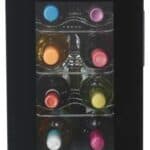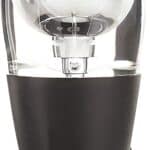Heard the terms dry and sweet being thrown around a dinner party or wine tasting and wasn’t sure what they meant?
You’ve arrived at the place.

And if you’re strapped for time, here’s the short answer:
Dry wine is wine that contains less than 1% residual sugar while sweet wine is wine that contains more than 5% residual sugar.
But there’s more to it than that, including grams of sugar per liter, the taste of dry wine vs the taste of sweet wine, the fermentation process for dry wine and sweet wine, and the different types of dry and sweet wine.
For the full answer (the answer that’s going to impress your friends the next time you go wine tasting), you need to keep reading.
What Is Dry Wine?
As mentioned above, dry wine is any wine that contains less than 1% residual sugar. Another way that a wine is considered dry is if it has less than 8 grams of residual sugar per liter.
We say residual sugar because it’s not the same as sugar. Residual sugar is the sugar from grapes left over after fermentation, which then results in how dry or sweet the wine is.
But here’s another fun fact: wine that contains less than 0.5% residual sugar is often called “bone dry”.
How Does Dry Wine Taste?
The taste of dry wine can be described as bitter or sour, with less of a full-bodied flavor.
And due to the low residual sugar content, dry wines are widely considered to be healthy – at least more so than sweet wines!
What Is Sweet Wine?
Unlike dry wine, which has less than 1% residual sugar, sweet wine has high residual sugar – more than 20%, to be exact. As for grams, sweet wines have more than 8 grams of residual sugar per liter, becoming more noticeable taste-wise at around the 35-gram-per-liter mark.
Again, this is due to the fermentation process and how much grape sugar is left over. And the more that’s left over, the sweeter the wine becomes.
How Does Sweet Wine Taste?
The taste of sweet wine is, well, sweet – not a big surprise considering that sweet wines have more residual sugar. Sweet wines are typically smoother on the palate, having more of a well-rounded, full-bodied flavor.
Needless to say, the high residual sugar content of sweet wine makes it generally less healthier than dry wine.
Dry Wine Vs Sweet Wine – The Main Differences
With the explanations out of the way, what are the main differences between dry wine and sweet wine?
Quickly summarizing the above points, the key differences between dry wine and sweet wine are:
- Dry wine contains low residual sugar (less than 8 grams per liter) while sweet wine contains high residual sugar (more than 8 grams per liter)
- Dry wine tastes bitter with a less full-bodied flavor while sweet wine tastes sweet with a more full-bodied flavor
- Dry wine is generally considered healthier than sweet wine
Dry Wine Vs Sweet Wine – How They Are Made
In short, wine is made by a step-by-step process that involves picking certain grapes, crushing those grapes, fermentation, and, lastly, aging.
After all that, the wine is bottled and ready to be sold.
But the most important step of this process is fermentation, which ultimately determines how the wine ends up tasting.
During fermentation, the sugar from the grapes slowly converts into alcohol, often encouraged by adding yeast. And how much of this sugar is converted results in, you guessed it, how sweet or dry the wine becomes.
If most of the sugar is converted into alcohol, it produces a dry wine. If just some of the sugar is converted, you get a sweet wine.
Both white wine and red wine can be dry or sweet.
Types Of Dry Wine And Sweet Wine – The Varieties
Now that you know the difference between dry wine and sweet wine, as well as how dry wine and sweet wine are made, it’s time to look at the most popular types of dry wines and sweet wines.
If you’re not shy to a glass of wine (or two), then you’re sure to recognize some of these wines.
Popular Dry Wines
- Pinot noir
- Pinot gris
- Chardonnay
- Tempranillo
- Cabernet sauvignon
- Sangiovese
- Sauvignon blanc
- Muscadet
Popular Sweet Wines
- Port
- White port
- Tawny port
- Ice wine
- Moscato
- White zinfandel
- Sauternes
- Mead
Dry Wine Or Sweet Wine – Which Is Better?
Whether dry wine or sweet wine is better ultimately comes down to personal preference. Some prefer the lighter, bitter taste of dry wine while others prefer the full-bodied, flavorsome taste of sweet wine.
For people who are on a diet, dry wine would therefore be the preferred choice.
But there are also certain situations where dry wine or sweet wine is better.
For example, dry wine is considered best for aperitifs (drinking before dinner) or during dinner – often used as a palate cleanser.
Sweet wine, on the other hand, is considered better to drink after dinner – served as a dessert wine, often with cheese.
These aren’t hard rules, though. And at wine tastings, you’ll usually be presented with a choice of dry wines and sweet wines to sample, meaning that both types of wines are popular, with neither being “better” than the other.
And for those who like both, medium-sweet wines do, in fact, exist!
Conclusion
Whether a wine ends up being dry or sweet happens during the fermentation process. The sugar from grapes converts to alcohol, and how much of this sugar is left to convert results in how dry or sweet the wine is.
In other words, the more sugar that’s converted, the drier the wine becomes.
Dry wine tastes bitter, sometimes sour, with a lighter, less full-bodied flavor. This is contrasted with sweet wine, which has a thick and full-flavored sweet taste.
Both white wine and red wine can be sweet or dry. Dry wines are often enjoyed before and during dinner while sweet wines are often enjoyed after dinner, sometimes called dessert wines.
Ultimately, though, dry wine and sweet wine can be enjoyed at any time, all boiling down to personal preference!
- How to Learn Wine Tasting: Essentials for Beginners - March 10, 2024
- How to Learn to Like Wine: Cultivating an Appreciation for the Vintner’s Art - March 10, 2024
- Thanksgiving Sangria: A Flavorful Twist to Your Holiday Table - August 27, 2023








